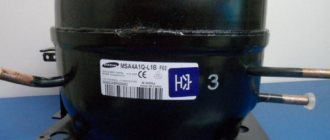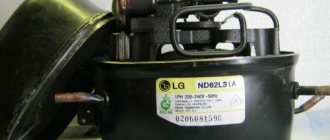Horizontal or vertical?
When transporting, the best option is to transport the refrigerator while standing. In this case, the oil from the compressor will not penetrate other components of the system, will not settle on the walls and mix with sediment and contaminants.
You can transport equipment in a lying position. But you must follow the rules for transporting a refrigerator. In this case, after transportation it cannot be turned on immediately. You need to let it sit for some time. We talked about this in more detail in the article “Why you can’t immediately turn on the refrigerator after delivery, transportation, transportation.” We recommend reading it; it will not be unnecessary information.
Tips: how to properly pack a refrigerator when moving on its side
Sometimes it is impossible to place the refrigerator in a car in an upright position. In this case, you can try to move it on its side, but in this case its safety cannot be guaranteed.
Transporting the refrigerator in a lying position is strictly prohibited. In this case, the device may not survive transportation.
Of course, manufacturers do not recommend transporting refrigerators horizontally, but when there is no other choice, this option is also possible. The main thing is not to transport the device on the door or on the back wall.
If you need to transport the refrigerator on its side, under no circumstances should it be placed on the back wall or door.
What can happen when transporting a refrigerator in a horizontal position:
- The tubes may break;
- The supercharger may become clogged with oil;
- Cracks may form on the compressor and freon may leak through them;
- Compressor mounts may fly off.
As you can see, the problems that may arise when transporting in a horizontal position are quite serious. However, by following some rules, you can transport the refrigerator to a new location safe and sound.
Rules for transporting a refrigerator in a lying position:
- Remove all shelves and drawers from the refrigerator and wrap each of them individually;
- Secure the refrigerator door in the closed position using tape or straps;
- Lay a blanket on the bottom of a wooden box and nail the planks to it on one side;
- Pack the refrigerator in a wooden box so that the tubes coming from the compressor face up;
- Place the box with the refrigerator in the car and secure it in it with supports and straps.
Of course, even following all these rules does not guarantee that when transporting the refrigerator on its side, it will not break. However, our tips will allow you to reduce the risk of malfunctions by 70%.
Transporting a new refrigerator
The rules for transporting a new refrigerator from the store depend on the manufacturer’s recommendations and the requirements of the service center. They need to be clarified with a representative, consultant, manager or seller. Check if they match those specified in the instructions.
If it turns out that you transported the equipment incorrectly, there is a risk of losing the warranty. If your refrigerator is damaged due to improper transportation, you will be denied service. There is a 99% chance that the warranty will be voided.
If the seller delivers the refrigerator or freezer to you, check exactly how they will transport it. Small shops may not have a truck, rigging, or other necessary equipment. If the refrigerator is damaged during delivery and you do not notice, the blame remains with you.
Transporting an old refrigerator
There are no specific rules for transporting an old or used refrigerator. it all depends on the situation:
- What vehicle are you transporting in?
- In what position is the refrigerator located?
- Is he well prepared for the move?
According to statistics from service centers, after self-transportation, 30% of refrigerators are found to have faults. In 90% of cases, this is due to improper transportation of the refrigerator during the move, preparation and mechanical damage. The remaining 10% are hidden damage that appeared during transportation.
Preparing to move
Before transporting the refrigerator you must:
- Remove all products from it;
- Defrost the refrigerator completely;
- Empty the condensate tray (located above the compressor);
- Remove (or protect) the legs or casters.
A container for water flowing from the walls is located above the refrigerator motor. It is usually hidden behind the back panel. It will have to be dismantled. After the moisture tray has drained, replace the panel.
Most refrigerators stand on adjustable legs or wheels. Dismantle them to avoid damage during handling and transportation. Usually they just unscrew (counterclockwise). In some models, the legs are located on an overhead plate. Remove it by unscrewing the mounting screws.
Advice
Before transporting, wash the refrigerator compartments. Clean the rear compartment where the compressor is located from dust and dirt. Such prevention will not be superfluous.
Preparation for transportation
Safe transportation requires not only proper placement in the truck, but also proper preparation. Necessary:
- Defrost, wash and dry the refrigerator in advance.
- Remove or tightly tape shelves and drawers inside with tape.
- Secure the refrigerator doors with tape.
- Pack the unit in several layers of bubble wrap or wrap it in cardboard and secure with tape. The ideal option is in preserved original packaging.
Upon arrival at the site, the unit should stand in the house for several hours, adapting to room temperature (if the move takes place during the cold season). Only after this can it be turned on.
Packing and fixing
Some refrigerator models have latches for shelves and drawers. They are used to transport the unit. You can fix the internal removable parts with their help.
It is better to remove all removable shelves, drawers, trays and transport them separately. This way you will slightly reduce the weight of the refrigerator, making it easier to carry and install. When transporting the shelves, place them between each other with cardboard, cloth or rags. Pack boxes and trays to protect them from scratches and impacts.
Secure the doors in the closed position with tape. Some models have special fasteners included in the kit. They are installed instead of standard hinges, or together with them.
Installation location of refrigerator door latches
Advice
To move the refrigerator around the house or apartment, place a large piece of thick fabric, a blanket, etc. under it. The floor covering will not be scratched or torn, the refrigerator can be pulled along the floor rather than carried.
If there is original packaging, use it to protect the refrigerator. If not, wrap it in bubble wrap to protect it from scratches. Fabric, cardboard, foam rubber, and any available packaging material are also suitable.
Pay special attention to the compressor and copper pipes. Some models have mounting brackets on the refrigerator motor. With their help, the compressor is attached to the housing for transportation. If there are no brackets, cover the motor with rags and rags, cardboard, and foam rubber.
The refrigerator compressor must be secured in such a way as to avoid vibration during transportation. Be careful not to damage the copper capillary tubes coming from it. do not allow distortions and deformations.
Important
Some people recommend using foam to secure the compressor. This is absolutely forbidden to do! When it hardens, it expands and can:
- Distort the refrigerator compressor;
- Damage copper tubes;
- Break the tightness of the connections;
- Deform the side walls.
Rules for transporting a refrigerator lying on its side
If it is not possible to transport the refrigerator while standing, you can transport it lying on its side. In this case, oil from the compressor must not be allowed to enter the condenser. During transportation, the refrigerator must be placed on its side so that the discharge tube is directed upward.
The instructions sometimes indicate on which side the refrigerator can be transported. “Left” and “right” are determined when you look at the front of the unit, not the back.
The instructions say that the refrigerator can be transported on its left side.
The discharge tube is the one that runs from the compressor to the condenser - heat exchanger (radiator) at the back of the refrigerator. If you cannot see their connection, read the next section.
Which tube is freon flowing in: how to determine without reading the instructions
Manufacturers intend that the cooling gas in the refrigerator is freon. As you know, it exits from the compressor through a tube to the rear of the housing, where it penetrates into the refrigeration chamber, supplying cold air. You must determine from which tube it is supplied and condenses when exposed to the external environment. This is done in order to lay the unit on the correct side. You should touch all the tubes coming out of the refrigerator motor, the one that will be hot is the one you need. It is this pipe that should face upward when transporting the unit.
Refrigerators equipped with a No Frost system (not requiring mechanical defrosting) must be transported in a strictly vertical position or at an angle not exceeding 40°.
How to determine the input and output of a compressor
There are two options for compressors for household refrigerators. The inlet and outlet of the refrigerant line can be located:
- On the one side;
- From opposite sides.
Compressor with capillary tubes located on one side
Compressor with opposite arrangement of freon tubes
In the first case, the refrigerator must be transported lying on its side so that both tubes are directed upward. In the second, you need to determine the inlet and outlet. Some compressors have markings on the housing or stickers:
- "Outlet", arrow in the direction from the compressor: copper tube going to the condenser;
- “Inlet”, “Suction Connector”, arrow in the direction of the compressor (no label): indicate the tube coming from the evaporator.
If there are no markings on the refrigerator motor, you can determine the position of the tubes yourself. Turn on the refrigerator (the doors should be closed) and check the temperature of the copper tubes with your hand once every half a minute to a minute. The tube that will heat up the most goes from the compressor to the condenser.
How to transport a refrigerator in a car
Is it possible to transport a refrigerator lying down in a car? Yes, you just need to decide on the method of transportation. There are three options:
- On the roof;
- In the back seat;
- In the trunk.
If you intend to transport the unit on a roof, secure it properly. Avoid sudden braking, accelerating and turning. It is best to transport the refrigerator lying down, but you can also stand up, securing it thoroughly (but not as in the photo).
Improper transportation of a poorly secured refrigerator while standing on the roof of a car.
Carrying in the back seat is the worst option. With this method of transportation, the refrigerator will be partially outside, the door will be open. visibility in the side rearview mirror will be difficult.
When transporting a refrigerator in the cabin, the car will take up a lot of space on the lane, and maneuverability will decrease. If there are no options, then position the unit so that the lower compartment with the compressor is inside the car.
Transporting a refrigerator in a passenger car.
Transporting a refrigerator in the trunk of a car is the best way. The only problem is that visibility through the rearview mirror may be difficult. When transporting in this way, place the refrigerator with the compressor facing forward in the direction of travel.
If the refrigerator does not fit in the trunk (this is usually the case with sedans), secure it with rigging straps. If, when placed parallel to the direction of travel, the unit does not lie stable, you can turn it diagonally (see photo).
Important
Regardless of the method of transportation, the refrigerator must be secured. Pay special attention to protecting corners, door hinges, door handles and the condenser (heat exchanger).
Is it possible to transport refrigerators in a lying position, and if not, why?
Every household appliance store has specially trained people who will answer your question: why you can’t transport the refrigerator lying down. Moreover, they will happily agree to solve this problem for a reasonable fee.
Specialists will pack your treasure correctly and take it wherever you want in a special car with high sides.
But since you are not looking for easy ways, then start by studying the structure of the unit in order to independently find a solution to this problem. Let's try to do this together.
Loading and transportation in a truck
If the refrigerator is loaded horizontally or at an angle, follow the same rule as when transporting it lying on its side: the discharge tube from the compressor to the condenser should be positioned vertically and “look” up.
It is convenient to use a special cart with two wheels for loading. With its help you can transport any large equipment and furniture. If there is no cart, you will have to do everything manually.
When transporting equipment, it is better to use pallets. It is convenient to tighten them with a special hook. Pallets are convenient for moving cargo around the body. They are especially convenient if a car is used for loading and unloading.
If you transport the refrigerator vertically, its center of mass will be located at the bottom. The risk of overturning when turning, accelerating or braking is minimal. But it is better to secure it to the floor, pallet or wall using a rigging rope or sling.
Refrigerator mounted in a truck.
Transporting a refrigerator in a trailer
There are two ways to transport a refrigerator in a trailer: standing or lying down. When transporting vertically, the refrigerator must be secured with slings or ropes. At the same time, it will interfere with the view from the rearview mirror in the cabin.
When transported horizontally in a trailer, the refrigerator may not fit. If transported in a standing position, it must be secured with rigging along the direction of the vehicle so that it does not fall out through the tailgate.
You can secure it across the trailer with ropes or slings, or place something (boxes, pieces of furniture, boxes). The unit must not move during transport. It is better to place it closer to the car. If he stands behind the trailer, due to the overweight, the lock can be torn off the tow bar.
If the refrigerator fits completely into the trailer, place it so that it rests against the wheel arch and one of the sides. Secure it in this position with slings, ropes, or other weights (see photo).
Transporting a refrigerator in a trailer. The unit is secured on the sides using another weight.
Preparation for transportation
The secret to safe transportation is simple - plan your trip, pack the item and secure it securely in the car. There are no problems with the new unit - the manufacturer has already made durable packaging.
But the model used on the farm needs to be properly prepared:
- You should start preparing the day before the move.
- The refrigerator compartment and freezer must be emptied of food.
- The equipment is disconnected from the power supply and completely defrosted.
- The equipment is wiped on all sides with a soap solution at room temperature without the use of aggressive household chemicals.
- You need to understand where the refrigerant pipe is located. It is always fixed vertically with tape.
- All structural elements located inside are removed. It is important to take out the drawers, shelves, everything that is inside. Each part is packed separately in paper or fabric.
- The water is drained and all surfaces inside are dried.
Reference ! The compressor is secured with rope, but it is better to use factory bolts. This will help it not to fly off from vibrations, shocks and shocks on the road.
Loading is permitted only after completing all the described actions. This is the answer to a common question about how to properly transport a refrigerator.
Loading is carried out by at least two loaders. To make working with heavy equipment easier, use harnesses, a wheeled pallet, or a dolly.
Not useful: transport at an angle
There is an opinion that it is possible to transport refrigerators at an angle of up to 40 degrees from the vertical. In this case, the oil from the compressor will not be able to get into the evaporator. But how practical is this?
In an inclined position, the unit will take up more space than in a vertical position (see figure). If you need to fit a 2-meter refrigerator into a truck with a ceiling height of 195 cm, you can try placing it at an angle. But it is easier to transport it in a lying position.
A refrigerator located at an angle is unstable. It needs to be supported, secured with ropes or slings. The corners of the unit experience heavy loads and can become deformed during vibration. If there are no other options, follow these simple rules:
- Secure the refrigerator using rigging to the sides of the car;
- Protect all corners and edges with foam, rubber, or other dense packing materials;
- Support the bottom with any objects;
- Try to completely eliminate vibration;
- When transporting, avoid sudden maneuvers, braking or speeding up.
Time of year and proper transportation of refrigerators
You can transport the refrigerator at any convenient time of the year. However, each weather has its own nuances for this process. For example, if you have planned a move in the winter, you must therefore remember that at frosty temperatures the oil from the compressor is compressed. Therefore, it is not recommended to start the unit immediately after installation. Allow the equipment to reach room temperature.
In summer, it is better to transport electrical appliances in closed, well-ventilated bodies. It is extremely important that the refrigerator does not heat up during transport. High temperatures will turn the motor oil into a liquid consistency.
The lying position creates additional pressure on the refrigerator, so after installation, make sure that the compressor is intact and does not move.
Transportation of a refrigerator with two compressors
All rules for transporting single-compressor refrigerators apply to units with two engines. But there is one exception. In some models of two-compressor refrigerators, the discharge tubes of the motors face in different directions.
It is not recommended to transport such units in a lying position. The maximum is in an inclined position, but best of all is in a vertical position. If you had to transport lying down, it doesn’t matter which side you’re on. After installation, you cannot immediately turn on the 2-compressor refrigerator.
Is it possible to transport a refrigerator lying down?
Most manufacturers insist that the device be transported in a strictly upright position to minimize the risk of damage to its parts.
But this option is not always possible: some refrigerators reach a height of two meters or more, so they cannot be transported “standing” in a regular trailer. You need to hire more serious transport, which entails additional costs.
A logical question arises: is it possible to transport a refrigerator lying down? - Yes, it’s possible, only by following a few simple rules.
New refrigerator
When purchasing a new refrigeration unit and transporting it yourself, pay attention to the box. The manufacturer has placed special drawings on it that indicate which side the refrigerator should be placed on during transportation. In addition, the packaging of the equipment is padded with foam, so you do not need to worry about the safety of expensive equipment.
Used refrigerator without packaging
If the refrigerator has already been used and the packaging has not been preserved, it can only be transported on one side.
To prevent the discharge tube from becoming clogged, it must be at the top during transportation. Only then will the oil not flow into the tubes of the refrigerant circuit, but will remain in the container.
When the equipment is placed in a vertical position, it will flow back.
How to find out which tube freon comes out of the engine
Refrigeration equipment is designed in such a way that the refrigerant (freon) flows through a tube from the compressor to the rear parts of the housing, from where it enters the chamber and supplies cold air. Your task is to determine which tube it comes from and condenses when interacting with the external environment.
To do this, turn off the unit, wait 15 minutes and carefully touch the tubes that come out of the device’s motor with your hand. The tube that turns out to be hotter is the discharge tube. It must be on top when transporting the refrigeration unit.
Be very careful when touching the discharge tube; it may be very hot and you may get burned.
Some devices have both tubes on the same side of the compressor. In this case, during transportation the device should be placed so that they “look” up.
How to transport a refrigerator with a No Frost system
The No Frost system is an innovative refrigeration and freezer cooling technology that was developed to replace the traditional drip method. This refrigerator does not require mechanical defrosting.
Refrigeration equipment with a No Frost system has an internal compressor suspension. The instructions for units with this technology indicate that they can be transported either vertically or at an angle of no more than 40°, otherwise the engine may become detached from the internal spring.
How long after transportation can you turn on the refrigerator?
When transported on its side, oil spreads throughout the compressor. It can get into the suction and discharge pipes. From them, the refrigeration lubricant enters the evaporator or condenser. It takes time for the compressor oil to drain down the device. That's why you can't turn on the refrigerator and freezer after transportation.
The time after which you can turn on the refrigerator depends on:
- Method of transportation (standing or lying down);
- Room temperatures;
- Temperatures outside.
The colder it is outside, the more the refrigeration oil cools. As the temperature drops, it thickens and takes longer to flow down the engine.
When installed in a warm room, the compressor gradually warms up, the oil becomes less viscous and more fluid. It takes less time to return to the compressor sump.
When transporting lying on its side, the refrigerator cannot be turned on:
- Summer: 12-18 hours;
- Autumn and spring: 18-24 hours;
- In winter: at least 24 hours.
After transportation, the refrigerator must stand up:
- Summer: 6-12 hours;
- Autumn and spring: 12-18 hours;
- In winter: at least 18 hours.
If the room temperature is below 15 °C, double the downtime. If the refrigeration unit is installed where it is colder than +10 degrees, you need to use a heater. It is necessary to warm up the compressor, the lower part of the evaporator and the condenser. A fan heater or infrared heater is best suited for this.
How long before refrigerators can be turned on after transportation and how should this be done?
And now recommendations on when to turn on the refrigerator after transportation. You shouldn’t feed it immediately as soon as you bring it. All its working fluids, disturbed during transportation, must drain and take their places. This will take several hours, or even days.
All internal fluids must take their place
If you transported the device in the cold, then you need to let it warm up in a warm room so that the thickened oil takes on its normal appearance and the condensation on the contacts evaporates. Hurry up, it means you will significantly shorten the life of this device. So if you doubt whether you can turn on the refrigerator immediately after delivery, remember that a couple of hours will not make a difference for your products, but will extend the life of the appliance.
Reasons why the refrigerator does not work after transportation
This section contains common reasons why a refrigerator or freezer does not turn on after transportation. If your equipment is having problems and you haven't found the answer here, ask your question in the comments .
The new refrigerator does not freeze, but the compressor turns on
Broken or cracked copper tube, capacitor or their connections. Due to depressurization, the refrigerant has escaped, so the compressor runs idle. The problem is solved by finding the leak, fixing it and refilling with freon.
The old refrigerator does not freeze, the compressor works
In this case, there are two options:
- During transportation, the freon line was damaged and a leak occurred. You won’t be able to fix the problem yourself; you need to call a specialist.
- Due to vibration, dirt or sediment accumulated in the system has formed a plug. You need to call a technician to clean the system.
After transportation, ice or snow began to form in the chamber
Most likely the seal is broken. This happens due to shaking, vibration, and shock during transportation of the refrigerator. Check door hinges, seals, interior panels and exterior frame components.
If you can’t find the reason for the depressurization, look for a specialist. Read more about the causes of freezing in the article “Why the back wall of the refrigerator freezes: we look for the cause and eliminate it.”
The compressor does not turn on in a used refrigerator
Sediment from the bottom of the compressor has mixed with the refrigeration oil. The mixture got into the moving mechanisms and jammed them. Try warming up the refrigerator engine with a hair dryer or fan heater. If it does not turn on after 20-30 minutes, call a technician.
The compressor in the new refrigerator does not turn on
Contact the service center under warranty. If it is not there, call a specialist. There can be many reasons:
- Manufacturing defects;
- Problems with electrical wiring;
- Mechanical damage to the engine;
- Much more.
The old refrigerator started to get very cold
The evaporator had a coat of ice that melted during transportation. The system began to work more efficiently. There is no need to solve the problem; set the required optimal temperature in the main and freezer compartments.
The main or freezer compartment began to work worse
In a single-circuit refrigerator, the cause may be a plug in the condenser, evaporator or capillary copper tubes. Only a specialist with the necessary equipment and tools can get rid of it.
In a double-circuit refrigerator, damage to one of the circuits is possible. If the compressor turns on more often or works harder from time to time, there are two possible reasons:
- Freon leak in one of the circuits;
- Failure of the air temperature sensor in the chamber;
- Thermostat is clogged or broken.
In the article, we tried to tell you how to properly transport a refrigerator in a car in different positions: standing, lying on its side, at an angle. We hope the publication was useful to you. Share the article with your friends and save it to your wall! You can ask your questions in the comments.
Do you want to get help from a master, a specialist in this field? Go to the professional search portal. This is a completely free service where you will find a professional who will solve your problem. You do not pay for posting an ad, views, or choosing a contractor. If you are a master of your craft, then register on Pro and receive a flow of clients. Your profit is just one click away!
Preparing refrigeration equipment for moving
The famous writer Scott Westerfeld in one of his novels described moving as a terrible thing, after which you never know where you will find it and where you will lose it. And this is true - when transporting property from one point to another, there is a huge risk of damaging or losing something.
In order to prevent such troubles, you need to properly plan the process itself, conscientiously pack the cargo and securely secure it inside the truck.
It is best to place the device in the original box. If it is not preserved, then you can wrap the unit in thick paper, cardboard, or special bubble wrap. Transporting the device without appropriate packaging is strictly prohibited.
If the refrigerator is new, the manufacturer must take care of its reliable and safe packaging even before the equipment reaches the store’s warehouse. If you intend to transport a unit already used on the farm, it is necessary to first prepare it for such a responsible operation.
Preparatory work usually begins 24 hours in advance, following the following procedure:
- empty the freezer compartment and refrigerator cabinet of existing products;
- disconnect the device from the power supply and wait for complete defrosting;
- Gently wash the inside and outside of the equipment with a neutral detergent (the best option is a warm soapy solution);
- remove all shelves, niches, drawers and balconies, packing each element separately in a piece of soft fabric or paper;
- drain the water and dry the insides thoroughly.
The compressor must be secured with shipping bolts or rope. Otherwise, due to strong shaking, vibrations and jolts, it can easily fly away from its place. The wire is carefully attached to the compressor with tape. In non-standard models of refrigerators that do not fit through the opening, the door is removed or the door frame is dismantled.
The doors of the device are also additionally secured with soft tightening straps, masking tape or regular rope. This is done so that they do not accidentally open or come off due to sudden movements.
You can start loading only after completing all the described processes. Ignoring at least one of them often leads to incorrect operation of the device in a new location. To carry the unit from the room to the car and vice versa, at least two people will be required.
A trolley, a pallet with wheels, or special safety belts will help make the task easier. According to transportation standards, equipment is carried in an upright position. The device must be loaded and unloaded into a trailer or body smoothly and carefully, avoiding sudden jolts and impacts. In this case, you must not grasp the door handle.
This video will demonstrate how to properly pack a refrigerator before transportation:











